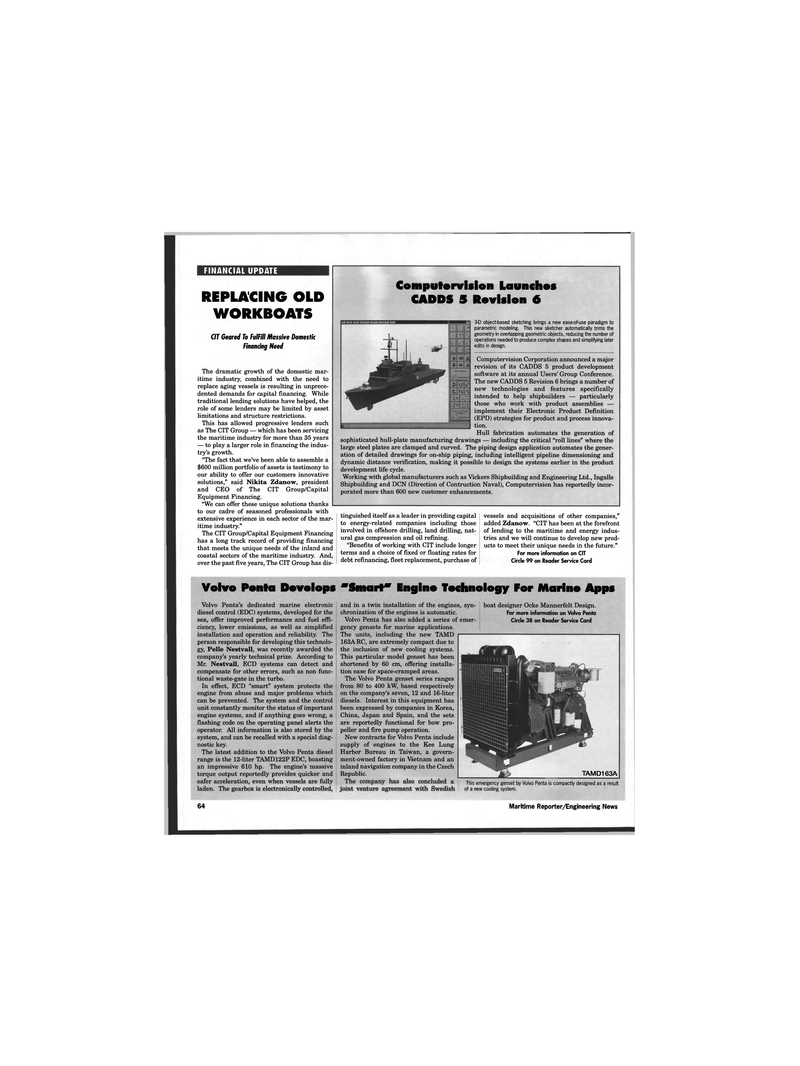
Page 62: of Maritime Reporter Magazine (November 1996)
Read this page in Pdf, Flash or Html5 edition of November 1996 Maritime Reporter Magazine
FINANCIAL UPDATE
REPLACING OLD
WORKBOATS
CIT Geared To FulFill Massive Domestic
Financing Need
The dramatic growth of the domestic mar- itime industry, combined with the need to replace aging vessels is resulting in unprece- dented demands for capital financing. While traditional lending solutions have helped, the role of some lenders may be limited by asset limitations and structure restrictions.
This has allowed progressive lenders such as The CIT Group — which has been servicing the maritime industry for more than 35 years — to play a larger role in financing the indus- try's growth. "The fact that we've been able to assemble a $600 million portfolio of assets is testimony to our ability to offer our customers innovative solutions," said Nikita Zdanow, president and CEO of The CIT Group/Capital
Equipment Financing. "We can offer these unique solutions thanks to our cadre of seasoned professionals with extensive experience in each sector of the mar- itime industry."
The CIT Group/Capital Equipment Financing has a long track record of providing financing that meets the unique needs of the inland and coastal sectors of the maritime industry. And, over the past five years, The CIT Group has dis-
Computervision Launches
CADDS 5 Revision 6 3-D object-based sketching brings a new ease-of-use paradigm to parametric modeling. This new sketcher automatically trims the geometry in overlapping geometric objects, reducing the number of operations needed to produce complex shapes and simplifying later edits in design.
Computervision Corporation announced a major revision of its CADDS 5 product development software at its annual Users' Group Conference.
The new CADDS 5 Revision 6 brings a number of new technologies and features specifically intended to help shipbuilders — particularly those who work with product assemblies — implement their Electronic Product Definition (EPD) strategies for product and process innova- tion.
Hull fabrication automates the generation of sophisticated hull-plate manufacturing drawings — including the critical "roll lines" where the large steel plates are clamped and curved. The piping design application automates the gener- ation of detailed drawings for on-ship piping, including intelligent pipeline dimensioning and dynamic distance verification, making it possible to design the systems earlier in the product development life cycle.
Working with global manufacturers such as Vickers Shipbuilding and Engineering Ltd., Ingalls
Shipbuilding and DCN (Direction of Contruction Naval), Computervision has reportedly incor- porated more than 600 new customer enhancements. tinguished itself as a leader in providing capital to energy-related companies including those involved in offshore drilling, land drilling, nat- ural gas compression and oil refining. "Benefits of working with CIT include longer terms and a choice of fixed or floating rates for debt refinancing, fleet replacement, purchase of vessels and acquisitions of other companies," added Zdanow. "CIT has been at the forefront of lending to the maritime and energy indus- tries and we will continue to develop new prod- ucts to meet their unique needs in the future."
For more information on CIT
Circle 99 on Reader Service Card
Volvo Penta Develops "Smart" Engine Technology For Marine Apps
Volvo Penta's dedicated marine electronic diesel control (EDC) systems, developed for the sea, offer improved performance and fuel effi- ciency, lower emissions, as well as simplified installation and operation and reliability. The person responsible for developing this technolo- gy, Pelle Nestvall, was recently awarded the company's yearly technical prize. According to
Mr. Nestvall, ECD systems can detect and compensate for other errors, such as non func- tional waste-gate in the turbo.
In effect, ECD "smart" system protects the engine from abuse and major problems which can be prevented. The system and the control unit constantly monitor the status of important engine systems, and if anything goes wrong, a flashing code on the operating panel alerts the operator. All information is also stored by the system, and can be recalled with a special diag- nostic key.
The latest addition to the Volvo Penta diesel range is the 12-liter TAMD122P EDC, boasting an impressive 610 hp. The engine's massive torque output reportedly provides quicker and safer acceleration, even when vessels are fully laden. The gearbox is electronically controlled, and in a twin installation of the engines, syn- chronization of the engines is automatic.
Volvo Penta has also added a series of emer- gency gensets for marine applications.
The units, including the new TAMD 163A RC, are extremely compact due to the inclusion of new cooling systems.
This particular model genset has been shortened by 60 cm, offering installa- tion ease for space-cramped areas.
The Volvo Penta genset series ranges from 80 to 400 kW, based respectively on the company's seven, 12 and 16-liter diesels. Interest in this equipment has been expressed by companies in Korea,
China, Japan and Spain, and the sets are reportedly functional for bow pro- peller and fire pump operation.
New contracts for Volvo Penta include supply of engines to the Kee Lung
Harbor Bureau in Taiwan, a govern- ment-owned factory in Vietnam and an inland navigation company in the Czech
Republic.
The company has also concluded a joint venture agreement with Swedish boat designer Ocke Mannerfelt Design.
For more information on Volvo Penta
Circle 38 on Reader Service Card
TAMD163A
This emergency genset by Volvo Penta is compactly designed as a result of a new cooling system. 64 Maritime Reporter/Engineering News

 61
61

 63
63
